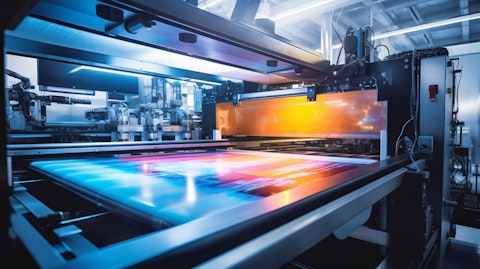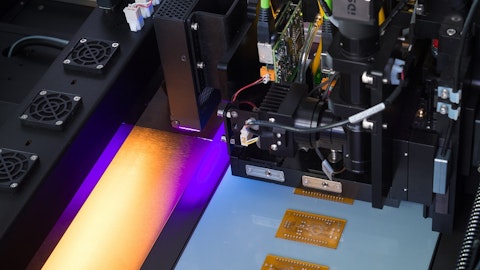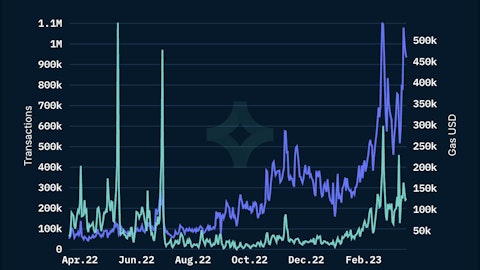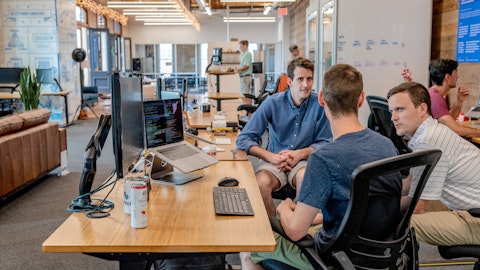TransAct Technologies Incorporated (NASDAQ:TACT) Q4 2023 Earnings Call Transcript March 12, 2024
TransAct Technologies Incorporated misses on earnings expectations. Reported EPS is $-0.01 EPS, expectations were $-0.00583. TransAct Technologies Incorporated isn’t one of the 30 most popular stocks among hedge funds at the end of the third quarter (see the details here).
Operator: Greetings, welcome to TransAct Technologies’ fourth quarter and full year 2023 earnings call. At this time, all participants are in a listen-only mode. A question-and-answer session will follow the formal presentation. [Operator Instructions]. Please note this conference is being recorded. I will now turn the conference over to Ryan Gardella, Investor Relations. Thank you. You may begin.
Ryan Gardella: Good afternoon, and welcome to TransAct Technologies’ fourth quarter and full year 2023 earnings call. Today, we’ll be discussing the results announced in our press release issued after market close. Joining us from the company is CEO, John Dillon; and President and CFO, Steve DeMartino. Today’s call will include discussions of the company’s key operating strategies, the progress of those initiatives, and details of the fourth quarter and full year financial results. We’ll then open the call to participants for questions. As a reminder, this conference call contains statements about future events and expectations, which are forward-looking in nature. Statements on this call may be deemed forward looking and actual results may differ materially.

For a full list of risks inherent to the business of the company, please refer to the company’s SEC filings, including its reports on Forms 10-K and 10-Q. TransAct undertakes no obligation to revise any forward-looking statements to reflect events or circumstances that occur after the call. Today’s call and webcast will include non-GAAP financial measures within the meaning of the SEC Regulation [indiscernible]. When required, reconciliation of all non-GAAP financial measures to the most directly comparable financial measures calculated and presented in accordance with GAAP, can be found in today’s press release as well as the company website. With that, I’ll turn the call over to John.
John Dillon: Thank you, Ryan, and good afternoon, everyone. Thanks for joining us today. ’23 has been a unique year for TransAct in many regards, and I’m happy to report that we closed it out with a fair amount of good news, and we believe that we are well set see increasing momentum in 2024. We reported $13.3 million for the fourth quarter and $72.6 million for the full year, reflecting results of changing dynamics in both of our main lines of business as we’ve been discussing in prior calls. On the FST side, food, service technology, we saw revenue of $4.7 million, that’s up about 54% year-over-year and 11% sequentially, with the recurring component of that revenue of $3.2 million, up 33% year-over-year and 2% sequentially, both to a record high.
As I discussed at length previously, FST was a major focus in our reorganization of TransAct Technologies, and we believe that we now have the right pieces in the right places, as we’re now focusing on selling our efforts to the top thousand organizations in the US and their related operations abroad to sell BOHA!, the Back of the House Automation platform. Additionally, we launched our new BOHA! terminal [Technical Difficulty] and BOHA! Terminal 2, we call it [Technical Difficulty] in ’23, and this is a high end enterprise grade solution, which will suitably be made for enterprise customers. And so, while we expect progress to be lumpy quarter to quarter as a small business would, we believe that we are seeing the first signs of momentum to build.
See also Female Smoking Rates by Country: Top 20 and 25 Countries With Highest Abortion Rates.
Q&A Session
Follow Transact Technologies Inc (NASDAQ:TACT)
Follow Transact Technologies Inc (NASDAQ:TACT)
And we sold 1,235 new BOHA! Terminals in the fourth quarter, bringing the annual total to 3,655 units sold during the year. We ended the year with a total of 14,514 online Terminals installed in the marketplace. We count that statistic because we think that’s a platform event and it’s an opportunity for cross-selling and upsize [Technical Difficulty]. We did see some benefit from international QSR that we talked about. That [Technical Difficulty] as mentioned on our last call, and [Technical Difficulty]. And after almost a year instituting major changes across the FST organization, we are encouraged by our sales numbers for the quarter, but acknowledge that we have much greater goals in mind for BOHA! and FST going forward. Our Terminal 2 and T2 continue to be well received by the customers that have seen it and prospects we showed it to, and we believe this new product will be crucial to growth going forward.
I also wanted to provide an update on the two new metrics, which I mentioned last quarter. One of them is pipeline growth, and the other one is new logos, also known as new customers. As part of my commitment to the TransAct shareholders, my goal has been to increase the transparency into the business. We felt this would be important to help investors evaluate the growth and future prospects for BOHA! And candidly, I use both of these metrics to run the business myself, they really matter, and I’m trying to watch sales progress and understanding that pipeline and understanding the success against that pipeline, are really important. On the FST pipeline growth side, let me give you some historical context first. Under previous FSC leaders there’s been some sporadic reporting the pipeline [Technical Difficulty].
And more importantly, I think subject to certain [Technical Difficulty], which may or may not, but after or the sales organization, we reorganized it, moved some people around, we took a hard look at the pipeline, scrubbed it, boiled it down to a place where we felt the pipeline was really reflective of the opportunity. And we had in front of us and represented a guidelines for the next four quarters, a possibility. And we tend to look at the pipeline quarterly, but we run out a — 12-month, four quarter rolling pipelines to look at the business, and we can see opportunities out four quarters out, one quarter out, two quarters, three quarters, and this is sort of what I’m reporting here. With this process was intensive, time consuming, but I’m satisfied that the pipe and our belief in the dollars and the opportunity in it are good and represent opportunities for TransAct to convert that pipe into revenue.
With this in mind, I’m pleased to report that the FST pipeline increased 161%, in a little more over the past two quarters. This represents a total amount that is several times larger than the current FST sales level, so that’s a good sign. And as a reminder, the BOHA! sales cycle is typically pretty long and somewhat complex, but it pays dividends in the long run. For businesses that operate in a franchise fashion, which are many of the clients that are in our prospect list, we almost always need to engage both the headquarters and the individual franchisees. This makes the sales process a little more complicated, but it’s typical for many of the most well established brands. So with that in mind, as part of the sales process, let me just say that we’re well on our way to getting headquarter-type approvals from some of the key accounts that you would expect us to go after.
And we’re optimistic that these approvals will begin to yield results as we move forward. The other new metric I want to provide is the FST new logos, also known as new customers, as opposed to follow-on business from within the installed base. And I think that’s a good metric because if you can’t sell new customers, that tells you something is not right. So in the fourth quarter of 2023, we added 12 new logos, including the international QSR, which I mentioned previously. Our reconfigured and retrained sales team is now focused on the enterprise part of the market, particularly, approximately the top thousand organizations in the United States, and then any of their operations overseas. And we will update you all next quarter in how each of these metrics are trending, with the first quarter of 2024 and are developed and moving forward, and we’ll provide the same metrics going forward every quarter.
Overall, I feel we’re well positioned to see some accelerating growth from FST, as we move forward in 2024. And while I anticipate the majority of tangible progress to occur in the back half of the year, I have confidence in the team we have in place. They’re well trained. We lowered the cost structure, as a result of cost-cutting measures that I discussed last quarter. So I think we’re in a pretty good place. On the casino and gaming side, we reported $4.2 million for the quarter, which is down an enormous 62% year-over-year, and I’m going to talk about that in a moment, and approximately, 54% sequentially. And full year revenue of $41.2 million. We’ve been discussing the challenge of the changing dynamics in the duopoly we share in the market we serve during the past several quarters, and I wanted to provide more of an update on the two most important factors.
First, from a competitive standpoint, we believe we’re beginning to see a slightly wider scale re-entry into the market from our main competitor, and expect possibly, to experience some pricing competition as they attempt to regain some of their lost market share. This has not been widespread as of yet, and it’s mainly confined to overseas markets. So we’re watching it carefully there, but it’s not significant at this point and we will keep you posted if that situation changes. Second, on the inventory side, we’re now hearing from almost all of our OEM customers, that they’re in an oversupply position and have been slowing order rates substantially. In short, these OEM customers of ours, overbought as the casino business rapidly rebounded, and at the same time, they tried to offset supply chain uncertainty by overbuying.
Everybody was in a panic. They couldn’t ship machines without our units. And so they would do anything they could to get them and to stockpile some of them for the future to make sure they didn’t have additional shortages. This dynamic continues to be the main reason for the sequential slowdown in the quarter, as we discussed on our last call. We expect the first quarter, this current quarter that we’re in of 2024, to be the peak of this oversupply effect, with orders picking up as we move forward throughout the year. Ultimately, we continue to estimate that our go-forward annual net sales run rate in the casino and gaming market should be about 15% to 20% higher than the historical pre-COVID averages and believe that this will be the case for 2024 as a whole, with sales numbers improving sequentially quarter to quarter.
Finally, I want to provide our financial outlook for 2024. We are currently expecting full year revenues of between $53 million and $58 million, and adjusted EBITDA approximately at the breakeven level. These ranges, take into account all the points I’ve already discussed today, I believe we’re well positioned to see acceleration in the business in 2024, after a year of rebuilding and cost cutting across the organization last year. We’ve got the right team in place, selling to the right customers and prospects on the FST side, and believe this should result in growing momentum as we move through the year. But keep in mind, the business is still small and results selling into the enterprise market will no doubt be somewhat lumpy. We’re beginning to see orders for this new T2 terminal.
It’s really a platform that can run a lot of different types of software and technology, so we’re excited about it. We saw orders start from our large international QSR and expect domestic orders for BOHA! from the same customer in the coming months. Pipeline growth and net new logo metrics were solid for the quarter. And I promise that we’ll continue to update investors on these numbers going forward, whether they’re good or bad, I’m going to report them. The casino and gaming line have seen some increased pressure. I think we’ve explained that we have confidence in our long-term run rates for 2024 and beyond, and that’s pretty much all I have for prepared remarks. And with that, I’ll turn the call over to Steve DeMartino. Steve?
Steve DeMartino: Thank you, John, and thanks, everyone, for joining us today. I’d like to start by discussing our fourth quarter and full year ’23 results in more detail. Total net sales for the fourth quarter were $13.3 million, which was down 26% compared to $8 million in the fourth quarter of 22. For the full year ’23, total net sales were $72.6 million, which was up 25% compared to $58.1 million in ’22, and within our financial outlook range we gave for the 2023 year. Sales from our Foodservice Technology market, or FST, for the fourth quarter were $4.7 million, which was up 11% sequentially and 54% compared to $3.1 million in the prior year period. For the full year, FST sales were $16.3 million, which was up 32% compared to $12.4 million in ’22.
These increases were largely due to higher terminal sales, including the launch and first sales of our new BOHA Terminal 2, as well as sales of centers and gateways to a new assisted living customer and higher recurring revenue. We sold 1,235 terminals in the fourth quarter ’23 and ended the year with 14,514 net new terminals installed in the market. Our recurring FST sales, which include software and service subscriptions, as well as consumable label sales for the fourth quarter reached a record high $3.2 million, which was up 33% compared to $2.4 million in the prior year period. For the full year, recurring FST sales were $11.1 million, also a record high and up 28% compared to $8.7 million for the full year ’22. Our ARPU for the fourth quarter of ’23 was $926.
That was up 15% compared to $806 in the fourth quarter of ’22, but down slightly sequentially from $929 in the third quarter of ’23. As a reminder, we’re currently selling some BOHA Terminals with no recurring revenue attached to them to start. While this presents an opportunity to sell recurring elements in the future, for now, they represent a drag to our ARPU numbers. Our casino and gaming sales were $4.2 million for the fourth quarter of ’23, which was down 62% from the fourth quarter of ’22. That was largely due to OEMs working down high levels of printer inventory that they stockpile during the supply crisis earlier in ’23, that’s now eased. For the full year ’23, casino and gaming sales were $41.2 million, which was up 37% year-over-year.
As John mentioned, we expect the dynamics we experienced during the fourth quarter to continue into the first half of ’24, with the most significant effect likely in the first quarter and improving thereafter. POS automation sales for the fourth quarter decreased 47% from the prior year to $1.6 million. For the full year, POS automation sales were $6.9 million, which was down 35% from the full year ’22. This decline was largely the result of difficult comps, as we experienced unusually high sales in ’22, due to our competitor’s inability to supply product. We believe the competitors in this market are now fully back online and expect Q4 to represent close to our normalized go forward sales rate. Moving to TransAct Services Group or TSG sales, for the fourth quarter, TSG sales nearly tripled year over year to $2.8 million.
This increase was largely due to unusually high sales of legacy lottery spare parts. For the full year ’23, TSG sales were $8.2 million which was up 61% from the full year ’22. So we had a very strong quarter and year of TSG sales and ’23. Sales of legacy lottery printers’ spare parts are sporadic, they’re hard to predict, and they can vary significantly from quarter to quarter. As a result of this, we don’t expect this level of sales to repeat in 2024. Moving down the income statement, our fourth-quarter gross margin was 48%, which was down sequentially from 51.9%, but up from 45.8% in the prior year period. Full year gross margin was 52.9% as compared to 42% in the full year ’22. This comes as a result, significantly higher sales and an improved mix of higher-margin casino gaming printer sales.
Also contributing to the increase, was the continued positive effect from two rounds of price increases that we instituted during ’22 and we’re able to largely maintain throughout ’23. However, based on an expected return to more normalized competitive dynamics in both our casino and gaming and POS automation markets in ’24, we expect our gross margin for ’24 to be somewhere in the mid 40% range. Our total operating expenses for the fourth quarter decreased by 11% to $6.9 million. And on a sequential basis, our operating expenses declined 11% as well. These declines come as a result of our previously discussed savings achieved from the cost cutting efforts, we began to put in place late in the third quarter. We estimate that these actions will produce operating expense savings of approximately $3 million on an annualized basis, and we experienced the full effect of these reductions during the fourth quarter.
For the full year ’23, operating expenses were $32.7 million, which was up 2% from the full year ’22. However, our ’23 operating expenses included a $1.5 million severance charge related to the resignation of our former CEO. Excluding this charge, our operating expenses actually declined 3% year-over-year. Breaking down our operating expenses a bit more, our engineering and R&D expenses for the fourth quarter were essentially flat from the prior year, increasing just 1% to $2.2 million. For the full year ’23, these expenses increased 10% year over year to $9.4 million. Our selling and marketing expenses decreased 90% to $2.1 million for the fourth quarter on a year-over-year basis. For the full year ’23, our selling and marketing expenses were $9.9 million, which was down 12% year over year.
The decrease was largely due to rightsizing changes related to our FST market that we made during the latter half of ’23, including reductions in head count, trade show, and overall marketing expense. Lastly, our G&A expenses decreased 12% to $2.6 million for the fourth quarter, largely due to lower stock incentive compensation expense, as well as lower bad debt expense and recruiting fees and post go-live support of the implementation of net suite that we incurred in the fourth quarter of ’22, that did not repeat. For the full year ’23, our G&A expenses were $13.3 million, which was up 9% from the full year ’22, largely due to the $1.5 million severance charge I mentioned earlier. Excluding this charge, G&A expenses declined 3% year-over-year.
For the fourth quarter, our operating loss was $522,000 or 3.9% of net sales, and this, compared to operating income of $494,000 or 2.8% of net sales in the prior year period. For the full year, we generated operating income of $5.7 million compared to an operating loss of $7.7 billion in ’22. And on the bottom line, we recorded a net loss of $62,000 or a penny loss per share for the fourth quarter, compared to net income of $260,000 or $0.03 per diluted share in the year ago period. For the full year ’23, we had net income of $4.8 million or $0.47 per diluted share, compared to a net loss of $5.9 million or $0.6 per diluted share in ’22. Our adjusted EBITDA for the quarter was $600,000, which compared to $1.3 million for the fourth quarter ’22.
And for the full year, our adjusted EBITDA was $10 million, which compared to negative $5.2 million in ’22. As an FYI, our adjusted EBITDA for the full year ’23 put us at the high end of our financial outlook. And turning to our balance sheet, it remains solid. We finished the year with $12.3 million in cash, which was up $4.4 million over the cash balance we had at the end of ’22. And in terms of debt, we had only the minimum required borrowing of $2.25 million under our credit facility, the CNO lending. And before opening the call for questions and answers, I wanted to take a moment to discuss our projected cash flow for ’24. With our 2024 outlook for projected adjusted EBITDA of around breakeven, we expect the business will also be around working capital neutral for the year.
We ended the year with a relatively high level of net inventory, about $17.8 million, which we expect to sell down as we move throughout ’24. We believe this inventory liquidation should provide enough cash to fund any anticipated growth in receivables and any other working capital items. We also expect a fairly typical year for capital expenditures. So given these factors, combined with our current financial outlook range, we believe we will likely end 2024 with a similar amount of cash and cash equivalents, as we had at the end of 23. And that’s it. And with that, I’d like to turn the call over to the operator for questions. Operator?
Operator: [Operator Instructions]. Our next question is from George Sutton with Craig-Hallum Capital Group. Please proceed.
George Sutton: Thank you. John, I wondered if you could walk through the decline quarter over quarter. Just give us a sense of the significance of the inventory issue in the quarter, relative to the competitive change in the quarter. And as you look forward to Q1, I think you’re suggesting Q1 will be below Q4 in that segment. Is that correct?
John Dillon: Steve, you’ll have to answer that.
Steve DeMartino: Yeah, we’re expecting that inventory overstock position that we experienced in Q4 is going to continue into the first half, but most of the effect we’re going to see is going to be in the first quarter. So a lot of the OEMs really have just really slowed down, in some cases, turned off the orders for a quarter or so.
John Dillon: Yeah, it’s interesting. We’ve been so supportive of our client base that they’d call us up and say, I need machines next week or tomorrow, and we can get them out to him. But when the supply shortage hit supply chain, they found they couldn’t ship machines, whether they were getting the machines from us or they’re getting from somebody else. And I wouldn’t say they panic, but they overbought because if you making up $30,000 to $50,000 slot machine and you need a TITO printer, ticket-in, ticket-out printer, to basically handle the cards, and you don’t have one whether you’re getting it from us or from our main competitor, you can’t ship that machine. So they went crazy, and the uncertainty in the supply chain caused them to place orders.
And frankly, it was a happy problem we had. We were doing a little bit of arbitrage and triage trying to give people enough machines, so they could ship as the casino and gaming industry rebounded. But the net result is both we and our clients have increased inventory, and we’re just going to have to work through that. And the good news is, all of our inventory is saleable, and frankly, I’ve been to Las Vegas lately and a lot of the casinos are back full tilt. We think that it’s I just want a normal- – supply and demand disruption that will work its way out and stabilize probably towards the end of the year. And as we pointed out, we believe that we picked up about 15% to 20% in sustainable market share, given that our competitor was missing in action during this whole rigmarole with the supply chain.
And we did not recede a little bit here and there, but not much yet. We expect them to be back. But the inroads we made, we believe we can keep most of them.
George Sutton: And just to be clear, Steve, did you say the revenues in casino this quarter were something you would anticipate as more normal going forward? Did I hear that correctly?
Steve DeMartino: No, what I was saying was the revenue for the POS market, George, that would be the run rate for Q4, should be a similar run rate as we go into 2024.
George Sutton: Okay. I’m happy. I heard that incorrectly –.
Steve DeMartino: Because you know, casino game is going to be lower in the beginning and it should ramp up as we go through the year once the customer, the OEMs work through their inventory issues, it should ramp again back to normal.
George Sutton: Yeah, and lastly, John, I wondered if you could just give us a sense of the 12 logos that you signed in the quarter and just the composition of them, what types of outlets are they and how significant if you fully roll out to them, would those be?
John Dillon: It’s hard to predict just from a sales focus standpoint. We’re not focusing on from an outbound standpoint on organizations that really can’t place orders for 50 to 100 units minimum. There are some holdovers and we don’t turn people away when they say, Hey, I really need these machines even if they’re small. So we’ve got a mix in there. It’s pretty much across the board. We mentioned that we had an interesting opportunity that we closed where we’re monitoring refrigerators and storage for additionals in a retirement home setting, where you can imagine people are taking a lot of expensive medicines and a very small little reefer. Then, hallway goes out, you might lose thousands of dollars in medicines or you might risk providing a medicine that is damaged somehow because it is not too hot.
So I’d say these things are some of that’s residual from the organizational structure we had before. Some of the deals were in the pipeline, but I’d say it’s a mix across the board, but I do think it represents some thousands of units over a period of time.
Operator: [Operator Instructions]. Our next question comes from Jeff Martin with Roth MKMV.
Jeff Martin: Could you give us an update and I know you’ve talked in the past you alluded to it brief very briefly this afternoon, but in terms of adding technologies, perhaps partnering with other technology providers or software companies on the BOHA! T2 terminal, are you seeing that become more prominent in the potential offering?
John Dillon: It’s a keen focus of mine, but it’s early days, so there really isn’t any color commentary that would be meaningful at this point. And I’ll point out that most — first of all, in the foodservice technology space, this has not anything to be I know denigrating or pejorative, but they’re technologically kind of laggards. They might be greater hospitality, great in a kitchen, great with cooking ingredients, and packaging, and all that, but they’re kind of slow to adopt technology. And what’s happened is — as an industry we’ve realized that this is a place where we can make a lot of improvement. Minimum wages are going through the roof, labor’s hard to get, and automation is possible, and we’re hoping that this industry, which has a very, very large TAM, total addressable market.




